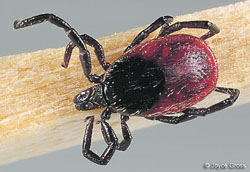| | Published July 7th, 2010
| Tick-Borne Disease
| | By Mona Miller, DVM |  | | Western Black Legged Tick - Ixodes pacificus - Female Photo Joyce Gross, San Leandro www.joycegross.com |
Tick-borne infectious diseases have become better known in North America in the past 20 years. Tick-borne diseases can affect dogs and cats, and often can serve as public health awareness for human disease as well. This can be a complicated topic since multiple factors are involved in a dog, cat or human becoming sick from a bacteria transmitted by ticks. These factors include co-infection of multiple bacteria by a single tick into an individual, geographic variability of bacteria found within ticks, whether the individual has acquired the bacteria while traveling outside its home area, and the individual's immune response to the bacterial infection. Generally, if an individual has adapted from an evolutionary perspective to the presence of the bacteria (a "reservoir-adapted host" species), there may be no disease symptoms. An example of this is a deer for the Lyme Disease bacteria Borrelia. But in a non-adapted species and with an individual who may have other immune system stresses, the disease may range from mild to very serious. This example would include a human or dog for Borrelia.
 Tick-borne diseases have a variety of symptoms, so it is hard to cover this topic completely. Signs can range from mild lethargy to life-threatening problems. Lyme Disease in dogs often presents as fever with joint pain and swelling. Anaplasmosis can show up as fever, lethargy, not eating and a moderate decrease in platelets (the tiny cells in the bloodstream that help initiate a blood clot). Ehrlichiosis can take forms ranging from acute (illness shows up in a few days) to chronic (long-lasting illness, over weeks or even months), and includes enlarged lymph nodes and weight loss. Most veterinarians consider tick-borne disease to be a possibility if a dog has a fever, enlarged lymph nodes and anemia or low platelet count.
Tick-borne diseases have a variety of symptoms, so it is hard to cover this topic completely. Signs can range from mild lethargy to life-threatening problems. Lyme Disease in dogs often presents as fever with joint pain and swelling. Anaplasmosis can show up as fever, lethargy, not eating and a moderate decrease in platelets (the tiny cells in the bloodstream that help initiate a blood clot). Ehrlichiosis can take forms ranging from acute (illness shows up in a few days) to chronic (long-lasting illness, over weeks or even months), and includes enlarged lymph nodes and weight loss. Most veterinarians consider tick-borne disease to be a possibility if a dog has a fever, enlarged lymph nodes and anemia or low platelet count.
 Northern California is considered an endemic area for a few important tick-borne diseases that affect dogs such as Lyme Disease, Ehrlichiosis and Anaplasmosis. These three can be easily screened with a relatively inexpensive blood test. The screening test checks for the presence of the dog's immune system proteins, called antibodies that indicate whether that dog has ever been exposed to the causative bacteria. It does not necessarily mean that the dog is suffering from an active infection. If the screening test is positive, more sensitive tests can be run to help establish a diagnosis.
Northern California is considered an endemic area for a few important tick-borne diseases that affect dogs such as Lyme Disease, Ehrlichiosis and Anaplasmosis. These three can be easily screened with a relatively inexpensive blood test. The screening test checks for the presence of the dog's immune system proteins, called antibodies that indicate whether that dog has ever been exposed to the causative bacteria. It does not necessarily mean that the dog is suffering from an active infection. If the screening test is positive, more sensitive tests can be run to help establish a diagnosis.
 Since diagnosing a tick-borne disease may be a process of gathering information, your veterinarian may recommend starting a course of antibiotics appropriate for the suspected bacteria at the beginning of the diagnostic process. In some cases, a positive response to antibiotics and history of having had ticks may be valuable information in addition to the blood tests and other diagnostic tests.
Since diagnosing a tick-borne disease may be a process of gathering information, your veterinarian may recommend starting a course of antibiotics appropriate for the suspected bacteria at the beginning of the diagnostic process. In some cases, a positive response to antibiotics and history of having had ticks may be valuable information in addition to the blood tests and other diagnostic tests.
 Two excellent websites that provide more detailed information about tick-borne diseases are www.cdc.gov/ticks/index.html (for a discussion of human disease) and www.veterinarypartner.com (for canine/feline disease). Two excellent websites that provide more detailed information about tick-borne diseases are www.cdc.gov/ticks/index.html (for a discussion of human disease) and www.veterinarypartner.com (for canine/feline disease).

|
 | | Dr. Mona S. Miller lives in Lafayette with her 4 year old son, yellow Labrador Retriever and grey cat. She has worked at Four Seasons Animal Hospital in Lafayette since moving here in 2001. She attended Cal as an undergrad, and received her DVM from U.C. Davis. She can be reached at Four Seasons, 938-7700, or by email to MonaSDVM@aol.com.
| | | | | | | | | | | Advertisement | | |
| | | | | | Comments | | | | | |  | | |
| | |  | | |
| | | | |





